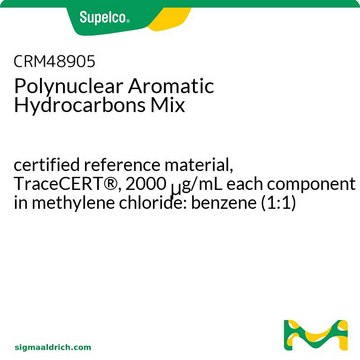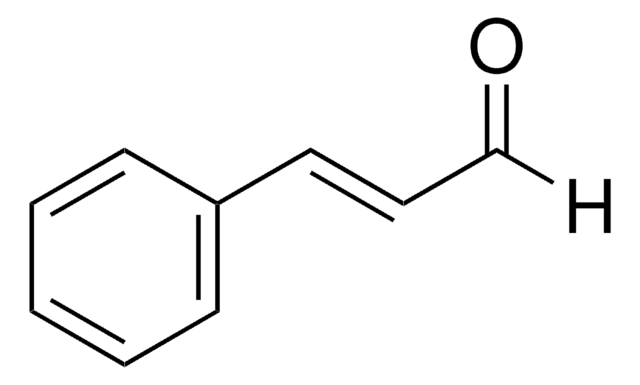等級
FG
Fragrance grade
Halal
Kosher
natural
agency
follows IFRA guidelines
法律遵循
EU Regulation 1223/2009
EU Regulation 1334/2008 & 178/2002
FDA 21 CFR 172.515
化驗
98%
bp
160-161 °C/12 mmHg (lit.)
mp
44.0-49.0 °C (lit.)
應用
flavors and fragrances
文件
see Safety & Documentation for available documents
食物過敏原
no known allergens
香料過敏原
no known allergens
感官的
cinnamon; woody; spicy; sweet
SMILES 字串
[H]C(=O)C=Cc1ccccc1OC
InChI
1S/C10H10O2/c1-12-10-7-3-2-5-9(10)6-4-8-11/h2-8H,1H3/b6-4+
InChI 密鑰
KKVZAVRSVHUSPL-GQCTYLIASA-N
尋找類似的產品? 前往 產品比較指南
應用
- Network pharmacology combined with molecular docking and experimental validation to explore the potential mechanism of Cinnamomi ramulus against ankylosing spondylitis.: This study investigates the anti-inflammatory potential of 2-Methoxycinnamaldehyde in Cinnamomi ramulus. Its application extends to novel therapeutic approaches for treating ankylosing spondylitis, demonstrating significant implications for medicinal chemistry and pharmacology (Wei et al., 2023).
- Ramulus Cinnamomi essential oil exerts an anti-inflammatory effect on RAW264.7 cells through N-acylethanolamine acid amidase inhibition.: The study elaborates on the anti-inflammatory activities of 2-Methoxycinnamaldehyde, offering a biochemical pathway that could be exploited in anti-inflammatory drug design (Jia et al., 2023).
- Metabolomics-Driven Exploration of the Antibacterial Activity and Mechanism of 2-Methoxycinnamaldehyde.: This article offers insights into the antibacterial properties of 2-Methoxycinnamaldehyde, using metabolomics to explore its mechanism of action, significant for developments in antimicrobial treatments (Qian et al., 2022).
訊號詞
Warning
危險聲明
危險分類
Eye Irrit. 2 - Skin Irrit. 2 - STOT SE 3
標靶器官
Respiratory system
儲存類別代碼
11 - Combustible Solids
水污染物質分類(WGK)
WGK 2
閃點(°F)
235.4 °F
閃點(°C)
113 °C
分析證明 (COA)
輸入產品批次/批號來搜索 分析證明 (COA)。在產品’s標籤上找到批次和批號,寫有 ‘Lot’或‘Batch’.。
客戶也查看了
Jian-you Guo et al.
Zhongguo Zhong yao za zhi = Zhongguo zhongyao zazhi = China journal of Chinese materia medica, 31(13), 1087-1090 (2006-10-20)
To observe the effect of 2-methoxycinnamaldehyde (isolated from fraction A of Guizhi Tang) on activity of COX and PGE2 release in rat cerebral microvascular endothelial cells (rCMEC) stimulated by IL-1. rCMEC were cultured, and identified by immunohistochemistry for von Willebrand
R Giordani et al.
Phytotherapy research : PTR, 20(1), 58-61 (2006-01-07)
The antifungal activity of the essential oil from Cinnamomum cassia, alone or combined with amphotericin B, a drug widely used for most indications despite side-effects was investigated. The composition of the oil was analysed by GC/MS and characterized by its
O B Samuelsen et al.
Xenobiotica; the fate of foreign compounds in biological systems, 16(9), 845-852 (1986-09-01)
The metabolism of o-methoxycinnamaldehyde (1.3 mmol/kg, intragastrically) was studied in rats. Identification of the urinary metabolites by g.l.c.-mass spectrometry and quantification by h.p.l.c. showed that the major metabolic pathway (approx. two-thirds of the dose) was oxidation to the corresponding cinnamic
R Montes-Belmont et al.
Journal of food protection, 61(5), 616-619 (1998-08-26)
The effects of 11 plant essential oils for maize kernel protection against Aspergillus flavus were studied. Tests were conducted to determine optimal levels of dosages for maize protection, effects of combinations of essential oils, and residual effects and toxicity of
Guang-Ping Lv et al.
Journal of separation science, 33(15), 2341-2348 (2010-06-24)
A pressurized liquid extraction and GC-MS method was developed for simultaneous quantitative determination of the seven components, including cinnamaldehyde, copaene, cinnamic acid, coumarin, 2-methoxycinnamaldehyde, 2-methoxycinnamic acid and safrole in Cinnamomum cassia. The results showed that methanol and ethanol was not
我們的科學家團隊在所有研究領域都有豐富的經驗,包括生命科學、材料科學、化學合成、色譜、分析等.
聯絡技術服務


